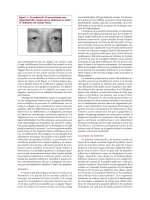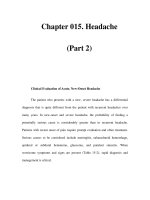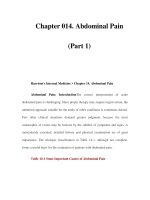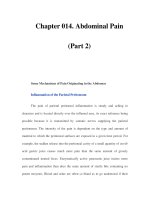Chapter 014. Abdominal Pain (Part 2) doc
Bạn đang xem bản rút gọn của tài liệu. Xem và tải ngay bản đầy đủ của tài liệu tại đây (13.55 KB, 5 trang )
Chapter 014. Abdominal Pain
(Part 2)
Some Mechanisms of Pain Originating in the Abdomen
Inflammation of the Parietal Peritoneum
The pain of parietal peritoneal inflammation is steady and aching in
character and is located directly over the inflamed area, its exact reference being
possible because it is transmitted by somatic nerves supplying the parietal
peritoneum. The intensity of the pain is dependent on the type and amount of
material to which the peritoneal surfaces are exposed in a given time period. For
example, the sudden release into the peritoneal cavity of a small quantity of sterile
acid gastric juice causes much more pain than the same amount of grossly
contaminated neutral feces. Enzymatically active pancreatic juice incites more
pain and inflammation than does the same amount of sterile bile containing no
potent enzymes. Blood and urine are often so bland as to go undetected if their
contact with the peritoneum has not been sudden and massive. In the case of
bacterial contamination, such as in pelvic inflammatory disease, the pain is
frequently of low intensity early in the illness until bacterial multiplication has
caused the elaboration of irritating substances.The rate at which the irritating
material is applied to the peritoneum is important. Perforated peptic ulcer may be
associated with entirely different clinical pictures dependent only on the rapidity
with which the gastric juice enters the peritoneal cavity.
The pain of peritoneal inflammation is invariably accentuated by pressure
or changes in tension of the peritoneum, whether produced by palpation or by
movement, as in coughing or sneezing. The patient with peritonitis lies quietly in
bed, preferring to avoid motion, in contrast to the patient with colic, who may
writhe incessantly.Another characteristic feature of peritoneal irritation is tonic
reflex spasm of the abdominal musculature, localized to the involved body
segment. The intensity of the tonic muscle spasm accompanying peritoneal
inflammation is dependent on the location of the inflammatory process, the rate at
which it develops, and the integrity of the nervous system. Spasm over a
perforated retrocecal appendix or perforated ulcer into the lesser peritoneal sac
may be minimal or absent because of the protective effect of overlying viscera. A
slowly developing process often greatly attenuates the degree of muscle spasm.
Catastrophic abdominal emergencies such as a perforated ulcer may be associated
with minimal or no detectable pain or muscle spasm in obtunded, seriously ill,
debilitated elderly patients or in psychotic patients.
Obstruction of Hollow Viscera
The pain of obstruction of hollow abdominal viscera is classically described
as intermittent, or colicky. Yet the lack of a truly cramping character should not be
misleading, because distention of a hollow viscus may produce steady pain with
only very occasional exacerbations. It is not nearly as well localized as the pain of
parietal peritoneal inflammation.
The colicky pain of obstruction of the small intestine is usually
periumbilical or supraumbilical and is poorly localized. As the intestine becomes
progressively dilated with loss of muscular tone, the colicky nature of the pain
may diminish. With superimposed strangulating obstruction, pain may spread to
the lower lumbar region if there is traction on the root of the mesentery. The
colicky pain of colonic obstruction is of lesser intensity than that of the small
intestine and is often located in the infraumbilical area. Lumbar radiation of pain is
common in colonic obstruction.
Sudden distention of the biliary tree produces a steady rather than colicky
type of pain; hence the term biliary colic is misleading. Acute distention of the
gallbladder usually causes pain in the right upper quadrant with radiation to the
right posterior region of the thorax or to the tip of the right scapula, and distention
of the common bile duct is often associated with pain in the epigastrium radiating
to the upper part of the lumbar region.
Considerable variation is common, however, so that differentiation between
these may be impossible. The typical subscapular pain or lumbar radiation is
frequently absent.
Gradual dilatation of the biliary tree, as in carcinoma of the head of the
pancreas, may cause no pain or only a mild aching sensation in the epigastrium or
right upper quadrant. The pain of distention of the pancreatic ducts is similar to
that described for distention of the common bile duct but, in addition, is very
frequently accentuated by recumbency and relieved by the upright position.
Obstruction of the urinary bladder results in dull suprapubic pain, usually
low in intensity. Restlessness without specific complaint of pain may be the only
sign of a distended bladder in an obtunded patient.
In contrast, acute obstruction of the intravesicular portion of the ureter is
characterized by severe suprapubic and flank pain that radiates to the penis,
scrotum, or inner aspect of the upper thigh. Obstruction of the ureteropelvic
junction is felt as pain in the costovertebral angle, whereas obstruction of the
remainder of the ureter is associated with flank pain that often extends into the
same side of the abdomen.









